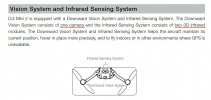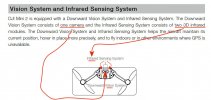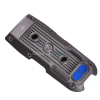There is only one optical sensor, and two infrared sensors. The optical sensor is used for horizontal position holding. The infrared sensors measure height.Cant the optical handle that like in the Mini2? {...] Could it be alignment of the optical sensors 2 patterns similar to how some of the first range finders in WW2 worked?

I'm not questioning whether the VPS is capable of that sort of range, or whether the infrared sensor heights are accurately being recorded into the flight log. The question is, what possible function is accomplished by this?I thought it switched to VPS at 98ft because the infrared was more accurate than the Barometer.
The drone's height is always controlled by the barometric altimeter, except when within ~2ft of any surface below its underside.
Unless you move the throttle stick to climb or descend, the drone will hold a constant height regardless of whether it's hovering in place, or moving forward/backward, or left/right. And it will hold that constant height regardless of whether the actual height over ground is changing due to sloping surfaces or obstacles like bushes and trees. The infrared sensor measurement never produces any visible effect at all on the drone's height, unless it registers something closer than ~2ft below it.
Let's say the drone is travelling at a constant height of 50' and it passes over a 25' tall tree. The barometer won't know the tree exists, so the drone remains at that same constant 50' height the whole time, clearing the top of the tree by 25'. The infrared sensors however can "see" the tree, and the flight log will record the VPS height changing from 50' above ground to suddenly only 25' above the top of the tree as the drone passes over, then back to 50' above ground once the drone clears the tree.
If, as you say, the VPS is somehow used to more accurately control the drone's height, wouldn't the drone suddenly jump 25' higher to maintain a constant 50' height above the ground, and 50' above any obstacles (trees) it encounters along the way? It doesn't do that because the drone's height is instead always controlled by the barometer, which never sees the tree.
The only time the infrared height sensors of the VPS system ever trigger any sort of noticeable reaction from the drone is if it encounters something closer than ~2ft underneath the drone.
Try flying slowly at low height over a picnic table. If the drone clears the table by at least 2ft, it's height never changes as it passes over the table because the height is controlled only by the barometric altimeter. But if you fly the drone lower than 2ft across the picnic table, the infrared sensors of the VPS system will detect the table top and the drone will automatically jump up in height to clear the table by at least 2ft, then continuing on at that new higher altitude.
If you fly too fast though, the drone reacts too slowly and may not jump up until after clearing the table top.













